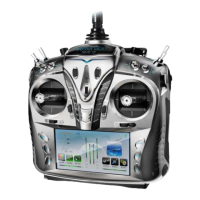
Do you have a question about the devention DEVO-12 and is the answer not in the manual?
| Brand | devention |
|---|---|
| Model | DEVO-12 |
| Category | Remote Control |
| Language | English |
Introduction to the DEVO-12 transmitter's features and technology.
Key statements and disclaimers regarding product usage and responsibility.
Crucial safety guidelines and precautions for operating the device.
Important checks and procedures to follow before commencing flight operations.
Overview of the key features and capabilities of the DEVO-12.
Technical specifications for the DEVO-12 transmitter and receiver.
Identification and definition of the transmitter's physical controls and components.
Instructions for adjusting the length and tension of the control sticks.
Explanation of how to switch between different control stick modes.
Procedures for switching the throttle from right-hand to left-hand operation.
Setup and usage of the trainer function for practicing flight control.
How to set up a unique fixed ID for binding the transmitter and receiver.
Guidelines for correctly installing the receiver in the model aircraft.
Proper installation and handling procedures for the DEVO-12 battery pack.
Overview of the transmitter's integrated system settings menu.
Settings for adjusting screen brightness, contrast, and backlight timeout.
Explanation of the four available stick modes and how to select them.
Adjusting the transmitter's output power level to manage radio range and battery life.
Managing saved model data, including selection, naming, and copying.
Instructions for copying model settings from one memory slot to another.
Restoring model data to factory default settings (batch or single reset).
Configuring functional switches like flight mode main/extra switches.
Selecting the appropriate swashplate type for helicopter control configurations.
Accessing and configuring various advanced flight control functions.
Setting dual rates and exponential curves for flight control sensitivity.
Configuring the throttle hold function to maintain a specific throttle position.
Configuring fail-safe behavior for loss of transmission signal.
Setting up and using the trainer function for practice flights.
Overview of the transmitter's integrated system settings menu for airplanes.
Settings for adjusting screen brightness, contrast, and backlight timeout.
Explanation of the four available stick modes and how to select them.
Managing saved model data, including selection, naming, and copying.
Instructions for copying model settings from one memory slot to another.
Choosing the aircraft type (Helicopter, Airplane, Glider) for the current model.
Configuring functional switches like flight mode main/extra switches.
Selecting wing configurations like Flaperon, DELTA, 4-Aileron, or V Tail.
Accessing and configuring various advanced flight control functions for airplanes.
Setting dual rates and exponential curves for flight control sensitivity.
Configuring the throttle hold function to maintain a specific throttle position.
Adjusting differential rates for control surfaces like ailerons, rudder, flaps, and brake.
Mixing aileron control inputs to affect flap response.
Configuring brake actions triggered by spoiler stick operation.
Creating custom mixes between various channels for advanced control.
Configuring fail-safe behavior for loss of transmission signal.
Overview of the transmitter's integrated system settings menu for gliders.
Settings for adjusting screen brightness, contrast, and backlight timeout.
Explanation of the four available stick modes and how to select them.
Managing saved model data, including selection, naming, and copying.
Instructions for copying model settings from one memory slot to another.
Fine-tuning servo neutral points using trim controls for various channels.
Configuring functional switches like flight mode main/extra switches.
Selecting wing configurations like V-Tail, Tip Ailerons, or Dual Spoilers.
Accessing and configuring various advanced flight control functions for gliders.
Setting dual rates and exponential curves for flight control sensitivity.
Adjusting differential rates for control surfaces like ailerons, rudder, flaps, and brake.
Creating custom mixes between various channels for advanced control.
Configuring fail-safe behavior for loss of transmission signal.
Configuring and using stopwatch and countdown timers.
